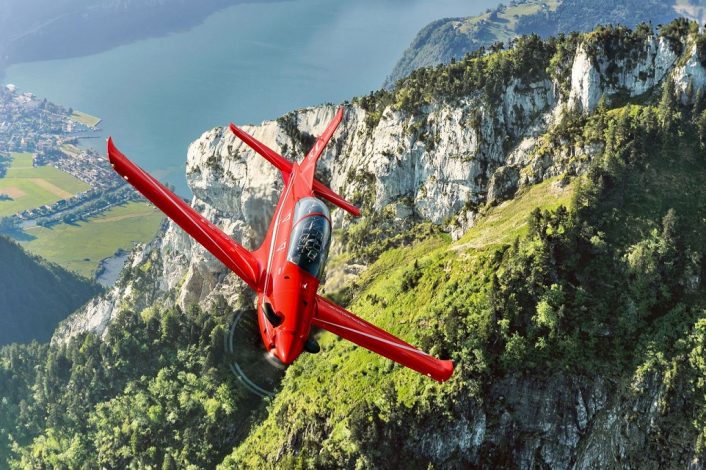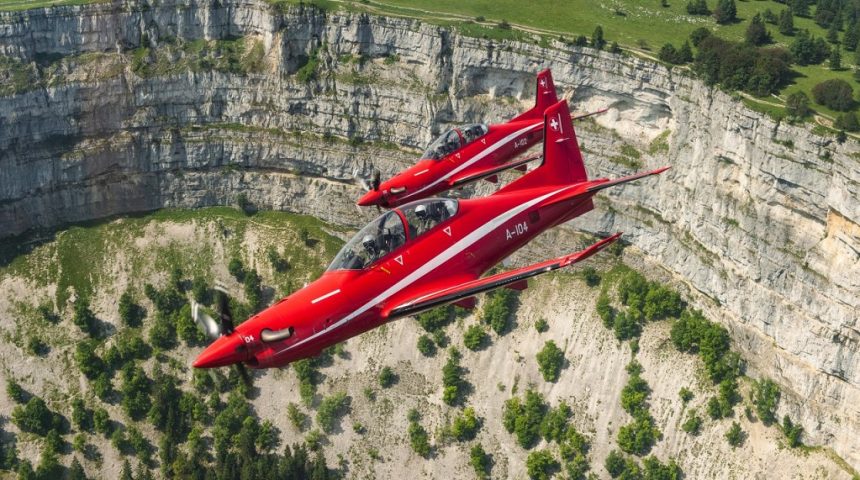Six Swiss PC-21 trainers will stay for ten days in southern Italy to train with the 61st Wing, their Italian counterpart for jet pilot training.
The Swiss Air Force is taking part in a 10-day training exchange with the Italian Air Force at Lecce-Galatina Air Base in the Apulia region in southern Italy. The training campaign, named “AMA ITA 21”, involves six Pilatus PC-21 trainers (serials A-102, A-104, A-105, A-106, A-107, A-108), six professional military student pilots (Swiss denomination for active duty pilots) of the Class 15/17, seven instructors and a team of eleven maintainers.
“We carry out this kind of training and improvement deployments abroad, in different countries, with all classes of the pilot school,” explained Lieutenant Colonel Michael von Jenner, flight instructor on PC-21 and detachment commander for “AMA ITA 21”. The last time the Swiss Air Force deployed to Lecce-Galatina was in 2012 and a new deployment last year had to be canceled due to the COVID-19 pandemic and postponed to 2021.
The Swiss, which are usually based at Emmen Air Base’s Pilot School Command, will be guests of their Italian counterpart, the 61° Stormo (Wing), until July 1, 2021, as part of a cooperation plan between the two countries. The aircraft arrived in Apulia on June 22, after a technical stop at Grosseto Air Base, and begun flying their first training missions the following day.
6x Swiss Air Force PC-21s in flight from Lecce-Galatina Air Base (Italy) in pairs. The Swiss trainers (serials A-102, A-104, A-105, A-106, A-107, A-108) will be there for 10 days for a training exchange. And yes, that’s the An-225 Mriya that just passed north of Lecce. pic.twitter.com/f8enl9JGy5
— Stefano D’Urso (@stedur93) June 24, 2021
Just a few days earlier, the Chiefs of Staff of both air forces, Lt. Gen. Alberto Rosso and Maj. Gen. Bernhard Müller, met in Rome after the renovation of the cooperation agreements which focus on training and airspace safety. Following the meeting, Major General Müller visited Lecce-Galatina Air Base and was briefed about the base’s activities, its mission and vision ahead of the arrival of the PC-21s.
Many goals have been set for “AMA ITA 21”, first of all the planning and execution of these training deployments abroad and the low level navigation and tactical training over an unfamiliar terrain. Another big goal is the exchange of experiences between the pilots of the two countries, further amplified by pilots taking part in training flights as passengers on their counterpart’s aircraft (Italian pilots flying on Swiss PC-21s and vice versa).
The Swiss Air Force operates a total of eight PC-21 trainers, acquired beginning from 2008. The PC-21 renovated the training of Swiss pilots, allowing a more practical transition from the PC-7 to the PC-21 and finally to the F/A-18 Hornet, as opposed to the older training system who required the pilots to transition from the PC-7 to the F-5 Tiger and then to the F/A-18.

The F-5 was not considered, in fact, the ideal training platform to satisfy the requirement needed by future F/A-18 pilots. Instead of the old “steam gauges” of the Tiger, the PC-21 has a sophisticated glass cockpit that enables to satisfy all the advanced training requirements, but the downside is that its Pratt & Whitney Canada PT6A turboprop provides limited powered compared to a jet engine.
Military flight training in Switzerland takes two years, with 30 weeks on the PC-7 and 45 weeks on the PC-21. During the latter, student pilots will undergo the technical conversion, instrument flight training (IFR), formation flying, navigation, air-to-ground attack, air policing and air warfare. The entire training cycle envisions a total of 210 missions for each student before they can successfully graduate.
The F/A-18 Hornet is not going to stay much more time in the inventory of the Swiss Air Force, with retirement planned by 2030. Because of this, as we have already reported, the government launched the “Air 2030” program to select its future fighter and evaluated four candidate aircraft: the Eurofighter Typhoon, the Boeing F/A-18 Super Hornet, the Dassault Rafale, and the Lockheed Martin F-35A Lightning II. A fifth candidate, the Gripen E, saw its evaluation cancelled after the Swiss procurement agency stated that only aircraft already operational in 2019 would be evaluated.
Last week, the Swiss public television reported that the F-35A won the evaluation, according to “insiders”. Should this be confirmed by the government, it would provide another chance of future cooperation with the Italian Air Force, as it already operates the type. The formal announcement of the winner of “Air 2030” is expected by June 30, 2021.









